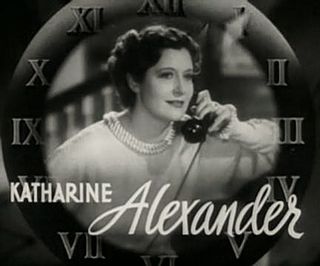
Stage Door is a 1937 American tragicomedy film directed by Gregory La Cava. Adapted from the 1936 play of the same name, it tells the story of several would-be actresses who live together in a boarding house at 158 West 58th Street in New York City. The film stars Katharine Hepburn, Ginger Rogers, Adolphe Menjou, Gail Patrick, Constance Collier, Andrea Leeds, Samuel S. Hinds and Lucille Ball. It was produced and distributed by RKO Pictures. Eve Arden and Ann Miller, who became notable in later films, play minor characters.

Ginger Rogers was an American actress, dancer and singer during the Golden Age of Hollywood. She won an Academy Award for Best Actress for her starring role in Kitty Foyle (1940), and performed during the 1930s in RKO's musical films with Fred Astaire. Her career continued on stage, radio and television throughout much of the 20th century.

Bachelor Mother (1939) is an American romantic comedy film directed by Garson Kanin, and starring Ginger Rogers, David Niven, and Charles Coburn. The screenplay was written by Norman Krasna from an Academy Award-nominated story by Felix Jackson written for the 1935 Austrian-Hungarian film Little Mother. With a plot full of mistaken identities, Bachelor Mother is a light-hearted treatment of the otherwise serious issues of child abandonment.

Gregory La Cava was an American film director of Italian descent best known for his films of the 1930s, including My Man Godfrey and Stage Door, which earned him nominations for Academy Award for Best Director.

Charles John "Tim" Holt III was an American actor. He was a popular Western star during the 1940s and early 1950s, appearing in forty-six B westerns released by RKO Pictures.

John Elmer Carson, known as Jack Carson, was a Canadian-born American film actor. Carson often played the role of comedic friend in films of the 1940s and 1950s, including The Strawberry Blonde (1941) with James Cagney and Arsenic and Old Lace (1944) with Cary Grant. He appeared in such dramas as Mildred Pierce (1945), A Star is Born (1954), and Cat on a Hot Tin Roof (1958). He worked for RKO and MGM, but most of his notable work was for Warner Bros.

Walter Connolly was an American character actor who appeared in almost 50 films from 1914 to 1939. His best known film is It Happened One Night (1934).

We're Not Married! is a 1952 American anthology romantic comedy film directed by Edmund Goulding. It was released by 20th Century Fox.

Kitty Foyle, subtitled The Natural History of a Woman, is a 1940 drama film starring Ginger Rogers, Dennis Morgan, and James Craig, based on Christopher Morley's 1939 bestseller Kitty Foyle. Rogers won the Academy Award for Best Actress for her portrayal of the title character, and the dress she wore in the film became known as a Kitty Foyle dress.

Rafter Romance is an American 1933 pre-Code romantic comedy film directed by William A. Seiter and released by RKO Radio Pictures. The film, which was based on the 1932 novel of the same name by John Wells, stars Ginger Rogers, Norman Foster and George Sidney, and features Robert Benchley, Laura Hope Crews and Guinn Williams.
Kathryn Elizabeth Doty, also known by her stage name Kathryn Adams or as Kathryn Adams Doty, was an American actress, novelist and psychologist.

Fashions of 1934 is a 1934 American pre-Code musical comedy film directed by William Dieterle with musical numbers created and directed by Busby Berkeley. The screenplay by F. Hugh Herbert and Carl Erickson was based on the story The Fashion Plate by Harry Collins and Warren Duff. The film stars William Powell, Bette Davis, Frank McHugh, Hugh Herbert, Verree Teasdale, and Reginald Owen, and features Henry O'Neill, Phillip Reed, Gordon Westcott, and Dorothy Burgess. The film's songs are by Sammy Fain (music) and Irving Kahal (lyrics). Sometime after its initial release, the title Fashions of 1934 was changed to Fashions, replacing the original title with an insert card stating "William Powell in 'Fashions'".

Dorothy Wilson was an American movie actress of the 1930s.

Verree Teasdale was an American actress born in Spokane, Washington.

Katharine Alexander was an American actress on stage and screen. She appeared in 44 films between 1930 and 1951.

Star of Midnight is a 1935 American mystery comedy film directed by Stephen Roberts. William Powell was loaned to RKO Pictures from MGM to star with Ginger Rogers.

Syncopation is a 1929 American pre-Code musical film directed by Bert Glennon and starring Barbara Bennett, Bobby Watson, and Ian Hunter. It was the second film produced by RKO Radio Pictures and the first to be released by the studio, in March 1929; the company's first produced film, Street Girl, was not released until August 1929. The film was made at the company's New York City studios and is based on the novel Stepping High by Gene Markey. The film was heavily marketed on its release, being the first film to be broadcast over the radio, as well as RKO's first sound musical, and was a significant success.

Fred Astaire and Ginger Rogers were dance partners in a total of 10 films, nine of them released by RKO Radio Pictures from 1933 to 1939, and one, The Barkleys of Broadway, by Metro-Goldwyn-Mayer in 1949, their only film in Technicolor.

The Sap from Syracuse is a 1930 American pre-Code comedy film directed by A. Edward Sutherland and written by John Griffith Wray, Jack O'Donnell, John Hayden and Gertrude Purcell. The film stars Jack Oakie, Ginger Rogers, Granville Bates, George Barbier and Verree Teasdale. It was released on July 26, 1930 by Paramount Pictures. The film was released under the title The Sap from Abroad in the United Kingdom.

Edward Arthur Killy was an American director, assistant director and production manager in films and television. He was one of the few individuals to be nominated for the short-lived Academy Award for Best Assistant Director. During his 30-year career he worked on over 75 films and television shows.





















